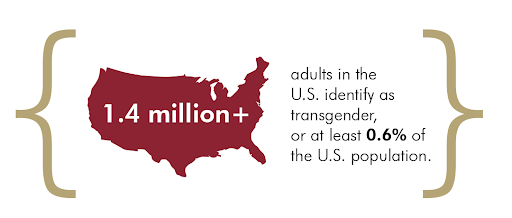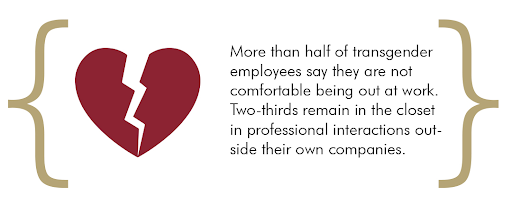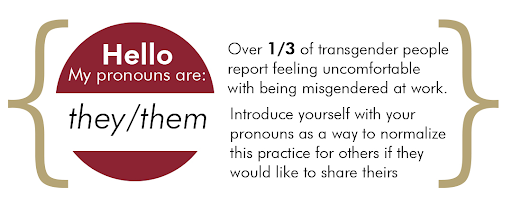Emphasizing and Empowering the T in LGBTQ for Allies and Transgender People in Tech

Transgender people have long been marginalized and excluded from many aspects of society, and the labor market is no exception. In spite of this, the technology industry has been one of the most welcoming industries to transgender people, from tech companies’ inclusive policies for transgender people to the innovation in tech tools for transgender people created within the industry.
In order to better serve the transgender community or make the workplace more welcoming for all employees, allyship is essential. Understanding their experiences and the unique challenges they face on a daily basis, as well as identifying solutions to these issues, contributes to the empowerment of transgender workers to thrive in the workplace and other settings.
Technology has led to tools that have helped break down barriers in employment for transgender individuals. Even the simple addition of pronouns to social media profiles, or use of avatars that do not emphasize gender in work meetings and communication can foster equitable experiences for everyone.
This guide discusses the role of technology in decreasing barriers in the workforce and provides tips for allies and employers on how to be more inclusive. Read on to find out how allyship can lead to a welcoming and supportive workforce for a transgender person looking to change careers or enter a new field.
Where transgender people are making headway
In recent years, more transgender people have begun to feel comfortable coming out and living as their true selves. This visibility has resulted in greater understanding and acceptance from the rest of the world, with transgender people now starting to see themselves represented in popular culture, politics, and other areas of public life.
In terms of full equality, there is still a long way to go. However, meaningful progress has become more apparent in recent years. Here are some examples of how transgender people are gaining true visibility:
- More states are passing laws protecting transgender people from discrimination in employment, housing, and public accommodations. In 2019, Massachusetts became the first state to ban conversion therapy for minors. In 2021, New York City passed a law making it easier for transgender people to change the gender on their birth certificates.
- There are now more openly transgender celebrities and public figures than ever before, including Laverne Cox, Caitlyn Jenner, Mj Rodriguez, and Janet Mock. This visibility helps to break down negative stereotypes and misconceptions about transgender people.
- More companies are becoming inclusive of transgender employees, with policies that allow them to use the restroom and locker room corresponding to their gender identity. Some companies are even offering transgender-inclusive health insurance coverage.
Despite these advances, full support and empowerment of the transgender community fully requires more work. We must continue to fight for equality in all areas of life so everyone can live their lives authentically and free from discrimination.

Top concerns for transgender individuals in work and school
Transgender individuals have to deal with discrimination, lack of understanding, microaggressions, and, unfortunately, violence. For these people, getting an education or keeping a job is more challenging than it is for their cisgendered classmates and colleagues. Here are some of the most common workplace and school concerns for transgender people:
Discrimination
Trans individuals face discrimination in many forms. They may be denied promotions or opportunities in the workplace because of their gender identity. In school, harassment by classmates or teachers is not uncommon [PDF, 5.9MB].
Lack of understanding
Many people do not understand what it means to be transgender, which can lead to isolation and loneliness. Transgender individuals shoulder the burden of explaining their identities and are often met with speculation or disrespect when they do.
Violence
Trans individuals are at a higher risk for violence, both physical and sexual. It is often due to hate crimes or discrimination and can make it hard to feel safe in the world.
Rejection from classmates or coworkers
It is not uncommon for transgender individuals to feel stigma and discrimination — or even hostility — from their classmates or coworkers. Whether this is due to ignorance or fear, it makes it difficult to feel like they belong.
Fear of being outed as transgender
Because of the reasons listed above, many transgender people are afraid of being outed as transgender. They avoid situations where they might be exposed, such as using public restrooms or changing in locker rooms.

Transgender people and technology
Professionals in the tech industry are working to create new technologies that will help transgender people, many of whom rely on technology to improve their lives and the lives of others. Here are some examples of how transgender people are utilizing technology to better their lives:
- Using social media to connect and build community.
- Using online dating apps to safely find romantic partners.
- Using crowdfunding platforms to finance transition-related costs.
- Using technology to create safe spaces for themselves and other transgender people.
This is only a small sample of how transgender people use technology to empower themselves. As transgender rights continue to be a source of contention in our society, it’s important to note that transgender people use technology to fight for their rights and improve their well-being.
Social platforms for transgender people
For many transgender people, social media provides a great way to connect with others who understand what they’re going through in a place where they can be themselves without fear of judgment or discrimination. Social media has also been used as a tool for activism and education. Trans people have used these platforms to speak out against injustices, educate the public about transgender issues, and build solidarity within the community.
Technology has even helped transgender people with their transitions. Online resources can provide information and support for those exploring their gender identity or seeking medical care, and trans-friendly apps and websites can help make the process of coming out and transitioning smoother.
Technology has been and will continue to be a vital part of the transgender experience. It is a way for trans individuals to connect with each other, share stories, and build visibility and understanding. In a world that often does not make space for them, technology is one of the ways they create their own communities and empower themselves.
As transgender individuals continue to fight for equality, amplifying their voices and stories through the use of technology is an ongoing process. By leveraging tech tools, we can create a more inclusive world for all.
Software, apps, and more
Outside of social media platforms and web-based resources and communities, there are quite a few different technologies out there that transgender people can use to help them in their everyday lives.
For instance, some transgender people choose to use voice-changing software to help them sound more like their preferred gender. Some apps and websites can also help transgender people keep track of their hormone levels and other medical information. And, of course, there are several ways to change one’s appearance through the use of filters. These technologies can be beneficial for transgender people in living their lives to feel more comfortable and authentic.
However, it is important to remember that not all transgender people use technology to help them in their lives, and some transgender people prefer to live without any technological assistance. There is no one right way to be trans, and each person gets to decide what works best for them and what makes them feel the most comfortable through their own unique version of transgender identity.
Safety for transgender people in the tech industry
Despite the marginalization and discrimination experienced within the transgender community, the tech industry has become a more welcoming place for transgender people.
Trans job-seekers should look for companies that have policies in place that support transgender employees. Typically, these businesses will have anti-discrimination policies that include gender identity and expression. They might also provide health insurance plans that cover transitional care. Furthermore, companies that have LGBTQ employee support groups or employee resource groups will likely promote a culture of inclusivity for transgender individuals.
Another way to find safety in the tech industry is to connect with other LGBTQ individuals who work in tech, such as through dedicated organizations and groups. These organizations can provide a sense of belonging and connection, valuable resources, networking opportunities, or help advance a career in the industry.
Many of these organizations also offer scholarships and mentorship programs specifically for transgender people, helping to ensure that transgender people have the opportunity to succeed in the tech industry.
There are also several conferences and meetups specifically for transgender people in tech. Attendance at these events is growing each year, as more transgender people feel comfortable coming out and being open about their identity in the tech community.
Working in tech as a transgender person
Working in tech can be an excellent way for transgender people to make a living. The industry is known for accepting diverse genders and sexualities, and many companies have policies in place to support transgender employees. In addition, working in tech can give transgender people the opportunity to use their skills and talents to make a difference.
As more transgender people enter the tech industry, they profoundly impact the transgender community at the same time, provide much-needed representation and visibility, and are helping to create an inclusive environment for all transgender people.
Their work is also helping to change how the world views transgender people. By breaking down barriers and breaking through stereotypes, they are helping to create a more accepting and understanding world for everyone.
Transgender people making strides in the tech industry
Trans individuals have been making significant strides in the workforce over the past few years. Forbes magazine has reported transgender entrepreneurs are making a name in the United States, and it has likely increased as more companies become trans-inclusive.
The representation of LGBTQ individuals in the tech industry is higher than in other industries, where LGBTQ individuals make up seven percent of the workforce, compared to four percent of Americans overall, according to polling firm Gallup.
In the U.S., TransTech Social Enterprises founder Angelica Ross created a space for training and co-working for trans people in tech, and in Brazil, Noah Scheffel runs a training company for trans people as well as inclusion training for tech industry employers, called EducaTRANSforma.
These are just a few of the many transgender people who are making waves in the technology industry. As more companies become more accepting of transgender employees, we will likely see even more success stories in the coming years.
Resources for allies
There are many ways to be an advocate for the transgender community. One way is to support companies that have trans-inclusive policies. Here is a list of some companies with pro-transgender advocacies:
Google has been outspoken about the rights of LGBTQ members and being inclusive in its company culture. They have partnered with the local LGBT chamber of commerce in pursuing growth in the careers of LGBTQ members through providing training and resources.
Apple has also been a supporter of transgender rights. In 2013, they released a statement supporting the Employment Non-Discrimination Act (ENDA).
Microsoft has shown support for the welfare and rights of the LGBTQ community and has been very open to welcoming LGBTQ members into the company while supporting different advocacies outside their premises.
You can help make the world a more inclusive place for transgender people by supporting these companies and others like them.
In addition to supporting companies with pro-transgender policies, there are other ways to be a transgender advocate. Here are some ideas:
- Educate yourself and others about transgender issues.
- Be an ally to the transgender community.
- Support transgender-led organizations and businesses.
- Use your privilege to help advance transgender rights.
- Stand up to transphobia and bigotry when you see it.
- Be a positive role model for transgender people.
You can help make the world a more inclusive and welcoming place for transgender people by doing your part.
How to be an ally to a transgender colleague
The act of allyship is defined as “when a person of privilege works in solidarity and partnership with a marginalized group of people to help take down the systems that challenge that group’s basic rights, equal access, and ability to thrive in our society.” It is about walking the walk with someone, rather than paving the way with what we think new goals should be. That said, it is important for workplaces to look at existing barriers and ways they can make small differences to help be more inclusive.
Pronouns matter
If you know someone who is transgender or gender non-conforming, be respectful of their pronouns and chosen name. Don’t make assumptions about their sexual orientation or gender identity. If you are unsure of what to say, just ask them how they would like to be referred to.
Understanding the “T” in LGBTQ can help create a more inclusive and tolerant world for everyone.

How can a workforce be more inclusive?
There are many ways to make a workforce more inclusive, one of which is to ensure that there is diversity in the workforce. Hiring a diverse range of employees from different ethnicities, genders, and backgrounds is the first step in establishing an equal workplace environment.
Another way to make a workforce more inclusive is to provide training and development opportunities for all employees. It includes offering training on cultural awareness and unconscious bias, as well as providing career development opportunities so everyone has the chance to progress within the company.
Making a workforce more inclusive takes commitment from everyone involved. It is a collective effort from the management to the employees to maintain an inclusive workplace where everyone can feel valued and respected, resulting in a more productive and effective workforce. If you are unsure where to start, try implementing some of these changes in your workplace.
Trans-inclusive design
Design should be for everyone, whether they are transgender, gender non-conforming, or nonbinary individuals. Trans-inclusive design is about creating products, environments, and experiences that are welcoming and accessible to all people, regardless of their gender identity.
It is important to remember that not everyone identifies as male or female, so using only these two genders when designing can exclude a large portion of the population. By making small changes in your designs to be more inclusive of transgender people, you can help create a more inclusive world for everyone.
Trans-specific work resources
The National Center for Transgender Equality is one such organization that offers resources and support for transgender job seekers. Another great resource is the Trans Employment Program, run by the Human Rights Campaign. This program provides training, resume assistance, and job placement services specifically for transgender people
Resources for transgender people
It is possible to find work resources tailored specifically for the transgender community with conscious effort. By utilizing these resources, transgender people can take control of their careers and build a bright future for themselves.
Join affinity groups for transgender professionals
There are some notable work affinity groups for transgender people. These include
- Human Rights Campaign is the largest LGBTQ civil rights organization in the United States. They focus on ensuring equality for LGBTQ people in all aspects of life, including at work.
- Transgender Law Center works to change laws and policies that discriminate against transgender people.
- The National Center for Transgender Equality aims to create a society where transgender people can live openly and free from discrimination.
The technology industry may be ahead of other, more traditional industries, but that doesn’t mean there is not work to be done. Part of this work is creating a safe space, both on and off site; this includes creating affinity groups and providing mental health resources.
Create a trans affinity group
Creating an affinity group for transgender employees at work can be a valuable way to support and advocate for transgender employees’ rights. Following these steps will allow you to create a safe and affirming space for transgender people to gather and share their experiences, while providing a valuable resource for transgender people in your workplace. It will eventually result in a more inclusive workplace for everyone.
Step 1: Talk to your HR department and let them know that you would like to create an affinity group for transgender employees. It is essential because they will need to allocate resources and permit you to use company space and time for meetings.
Step 2: Find other transgender employees who might be interested in joining or heading the affinity group. This can be done by talking to friends and colleagues or searching online.
Step 3: Once you have a group of interested people, start planning meetings and events like social gatherings, educational presentations, or advocacy work.
Step 4: Keep the group going by being active and supportive of members. It includes promoting a safe and welcoming environment, being an ally to other members, and continuing to plan engaging events.
Step 5: Reach out to other affinity groups at your company or within your industry. It can help with networking, sharing resources, and expanding your support system.
Mental health help and resources
Below are some resources that can help transgender people with mental health, transition concerns and staying healthy.
The Trevor Project
The Trevor Project is a national organization providing crisis intervention and suicide prevention services to lesbian, gay, bisexual, transgender, queer, and questioning (LGBTQ) young people under 25.
Trans Lifeline
Trans Lifeline is a nonprofit dedicated to the well-being of transgender people. They offer peer support and crisis intervention services to transgender people in the U.S. and Canada.
Transgender Gender Variant Intersex Justice Project (TGIJP)
TGIJP works to end human rights abuses committed against transgender, gender variant, and intersex people in California prisons and jails.
National Center for Transgender Equality
The National Center for Transgender Equality is the nation’s leading social justice advocacy organization winning life-saving change for transgender people.
Workplace Support and Affirming Behaviors: Moving Toward a Transgender, Gender Diverse, and Non-Binary Friendly Workplace
This article focuses on the experiences of transgender workers in today’s world. It also looks at how others view non-binary workers and how different attitudes toward transgender coworkers can keep those employees from feeling satisfied.
Transgender: Ensuring Mental Health
The Cleveland Clinic points out that, while being transgender is not a form of mental illness, transgender individuals still must have resources and assistance for their mental health concerns, particularly within the workplace.
Why Workplace Mental Health Policies Must Take LGBTQ+ Experiences Into Account
Garen Staglin created a piece for Forbes that details the challenges transgender employees face in the workplace, and how employers now need to take their experiences into consideration.
Employment, Mental Health, Internalized Stigma, and Coping With Transphobia Among Transgender Individuals
Researchers working for two different universities came together for this study, which shows that transgender workers now face transphobia from both their employers and coworkers, as well as internal stigma when coping with challenges.
Workplace Mental Health for LGBTQ+ Professionals
Bernie Wong looks at how companies celebrate Pride Month compared with the support they offer to their transgender employees. He discovered that discrimination in different sectors is on the rise.
Understanding Mental Health in the Transgender Community
Doctor Deb Thorpe goes over mental illness and other important issues that those in the transgender community face. She also talks about how loved ones and coworkers can find resources to support transgender individuals.
Trans People, Transitioning, Mental Health, Life, and Job Satisfaction
Published in the Handbook of Labor, this study from Nick Drydakis at Anglia Ruskin University discusses how successfully transitioning can help transgender workers feel better about themselves and more satisfied at work.
LGBTQI Mental Health from NAMI
The National Alliance for Mental Health talks about some of the issues that can lead to a mental health emergency among transgender workers, such as coming out to their peers, and where they can get help.
Transgender Mental Health Care on the Transition Pathway
Three professionals working in Duke University’s Department of Psychiatry & Behavioral Sciences discuss the common issues transgender people face at work and how schools can better prepare them.
How to Celebrate Transgender Employees on TDOV and Year-Round
Out & Equal Workplace Advocates provides a list of ways employers can celebrate their transgender employees, such as using preferred pronouns and helping them outside of the annual Pride Month celebration and acknowledgement.
Transgender Crisis Resources and Associations
Black Trans
This organization provides a safe space for Black trans individuals. Visitors can learn more about job opportunities and find resources in their areas.
Gender Diversity
Gender Diversity centers on the idea that all people deserve respect. It offers seminars and assistance for workplaces that want to be more inclusive and sensitive to transgender workers.
Brave Space LLC
Brave Space offers resources for non-binary and transgender visitors in the form of clothing drives and counseling, as well as legal help for those facing discrimination at work.
Gender Spectrum
Gender Spectrum allows visitors to describe their situations and choose the type of aid they need, such as social service or employment assistance. The organization also holds an annual conference to address pertinent issues.
Trans Equality
National Center for Transgender Equality helps users understand all of their employment rights and anti-discrimination laws. They also provide information about the number of transgender workers who lose their jobs each year.
Trans Women of Color Collective
The Trans Women of Color Collective focuses on the unique challenges facing women of color who transition, including the hurdles they encounter in finding work and paying for school.
Trans Veteran
TAVA wants trans veterans to know that they are not alone and that help is available through programs such as community healing events and getting gender-affirming surgery through the VA.
Out and Equal Workplace Advocates
Aimee Stephens penned this open letter after losing her job for being transgender because she wanted to directly talk to employers and show them why they should foster more open-minded workspaces.
Transgender Law Center
The Transgender Law Center offers assistance to individuals facing discrimination because they are transgender, including losing their jobs and feeling forced to quit or leave school.
Empower the T in LGBTQ
We can all play a part in emphasizing and empowering the T in LGBTQ through the creation of a safe and welcoming environment for everyone, regardless of gender identity or sexual orientation. By working together, we can make sure that every person feels comfortable being themselves and has an equal opportunity to succeed in educational and professional environments.

 Live Chat
Live Chat